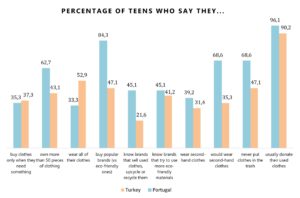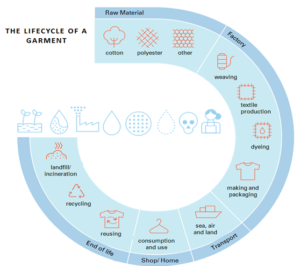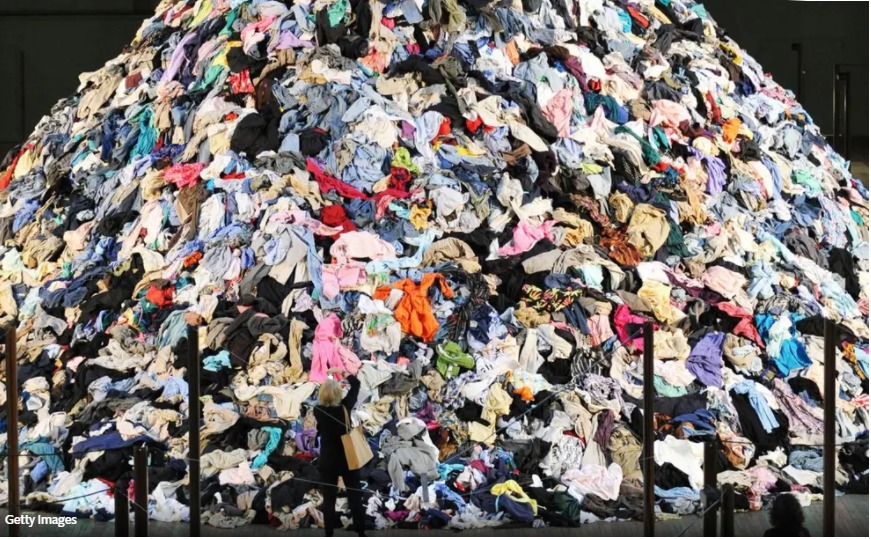How aware are young consumers of these issues?
Some answers aren’t very encouraging. Most teens say they don’t read labels, don’t consider clothes’ environmental impact, only have a vague idea about which raw materials are more eco-friendly and ignore the water consumption of clothes’ production. In contrast, written comments show many are concerned about these problems.

Survey answered by 50 Portuguese and 50 Turkish teens, aged 14-17, March 2021
Teens own many clothes. In Turkey over 50% say they wear them all but, in Portugal, this percentage is lower.
A Portuguese teen says, “I ask myself 3 things before buying clothing: if I need it, how many times I’ll use it, and if it’s timeless.” However, in both countries, less than 50% teens buy clothes only when they need them.
Most teens say their choice is mainly a stylish one. Others say they don’t know eco-friendly brands. “If two brands have a similar product, I’ll choose the eco-friendly brand,” a Turkish teenager declares, and a Portuguese one explains, “They are much more expensive than popular brands and it’s difficult to guarantee they’re eco-friendly”.
Thankfully, the percentage of youths who donate their clothes is extremely high, and the combined percentage of teens who never dump clothes is positive. The majority also try to buy clothes that last longer.
Why should we take this issue seriously?
Nowadays, consumers buy 60% more clothes than 20 years ago (2), which has increased production and waste. However, the environmental impact of fashion is still underestimated (3). This industry is the second-largest water consumer worldwide (4), produces 20% of global wastewater (5), and is responsible for 10% of all CO2 emissions – more than aviation and shipping combined (6).

The Lifecycle of a Garment (7)
After use, 87% of textiles are sent to landfills while, globally, less than 1% of clothes are recycled as clothing (8), and if not recycled, synthetic fibres, like polyester take around 200 years to decompose (9). Furthermore, washing synthetics releases tonnes of microfibres in the ocean every year. There is also the dyeing and treatment of fabrics with toxic chemicals, which are then passed on to fish, coming to our table.
Many garments are made from a water-intensive plant: cotton. Did you know it takes around 10,000 litres of water to produce a pair of jeans? (10). Now, multiply that by the number of jeans you’ve got! Cotton farming is also responsible for insecticides and pesticides (11). In Turkey, fertilizers used in cotton production are usually based on nitrogen and “Between 1997-2001 (…) an average of 9,000 tonnes of nitrogen per year leaked into water resources.” (12) Turkey is the 7th largest textile and clothing exporter in the world and since this industry is a major water user, it’s relatable that the industry is creating water shortage risk (13).
Dumping clothes means throwing away the resources to make new ones. A study based on data from 2016 identified Portugal as the second largest producer of textile waste in the EU (14); in 2018, 189,873 tonnes of textiles were collected, but only 23 were recycled (15). And, in Turkey, 1,300,000 tonnes of textile waste emerge each year (16).
The path towards sustainability
The good news is the actions towards sustainability have been growing steadily. Currently, “Portugal is the world leader for high-quality technical textiles”, including fabrics made from recycled materials (17) while the ‘Zero Waste Project’ in Turkey fulfilled the goals of UNDP. Both municipalities in Eskişehir received the zero-waste certificate. In 2020, 146 tonnes of textiles were recycled by Tepebaşı Municipality (18).
Fashion creators are also realizing the need to become environmentally sustainable. Design student, Catarina (19), told us “teachers instil this awareness in us, as potential creators of a brand.” Marta (20), from Näz, explained “We design with zero waste in mind.” using textile waste from surrounding factories to create new yarn. “The process is mechanical, using very little water.”
The Turkish company Çalık denim also leads unique innovative technologies, like D-Clear, which reduces water by 40% in dyeing, 83% in the finishing process, and uses 94% less chemicals (21).
Reducing the environmental impact of this industry is also the responsibility of consumers.
How can we contribute to this effort?
We asked this question to Portuguese journalist Vera Moutinho (22) and to Turkish sustainable-life blogger, Gamze Biran (23). They stressed the urgency of tackling this problem and gave us some advice:
Avoiding throwing out clothes – Extend their life cycle by repairing and upcycling them. Sell or donate them to friends or to charity. Finally, put them in textile recycling bins.
Making conscious choices – Learn to read labels and which fabrics are less harmful to the environment. Prefer natural fibres like linen, hemp, or lyocell.
Buying sustainable brands – They have ecological certication, as the “green label” by OEKO-TEX®, identifying all stages of production. Buying local brands makes this easier and reduces the carbon emissions of transportation.
Buying less – Shop only what you need and stop buying fast fashion. Purchase timeless, high-quality items. Exchanging clothes, buying second-hand or renting are also great options.
We have already started taking action by questioning other youths, preparing presentations and debates, practising what to look for in a label, and we’re organising a clothes swap at school.
You play an important role in preventing these dangers by changing the way you shop and act. Let “less is more” be the idea of fashion because, in the words of a survey respondent, “A good planet is hard to find!”
Webography and interviews:
1.May, Naomi.”This exercise is greenwashing at its absolute worst: the truth about fashion’s recycling bins”, Evening Standard, 05 August 2020, https://www.standard.co.uk/insider/fashion/fashion-recycling-bins-primark-fast-fashion-sustainability-a4512311.html . Accessed 10 April 2021.
2.Reichart Elizabeth, Drew Deborah. By the Numbers: The Economic, Social and Environmental Impacts of “Fast Fashion.” World Resources Institute, January 10, 2019, https://www.wri.org/insights/numbers-economic-social-and-environmental-impacts-fast-fashion . Accessed 24 April 2021.
3.“Fashion and the SDGs: what role for the UN? The fashion industry in numbers’’. The UN Economic Commission for Europe, 01 March 2018, https://unece.org/DAM/RCM_Website/RFSD_2018_Side_event_sustainable_fashion.pdf. Accessed 24 April 2021.
4.“What is the UN Alliance for Sustainable Fashion?’’ UN Alliance For Sustainable Fashion, https://unfashionalliance.org. Accessed 20 March 2021.
5.“Putting the brakes on fashion’’. United Nations Environment Programme, 12 November 2018, https://www.unep.org/news-and-stories/story/putting-brakes-fast-fashion . Accessed 25 April 2021
6.“UN Helps Fashion Industry Shift to Low Carbon’’. United Nations Climate Change, 6 September 2018, https://unfccc.int/news/un-helps-fashion-industry-shift-to-low-carbon. Accessed 25 April 2021.
7.Mendonça, Cátia, at al. “Moda Sustentável – A pegada da nossa Roupa”, Jornal Público, 29 November 2019, https://www.publico.pt/2019/11/29/infografia/pegada-roupa-391. Accessed 25 January 2021.
8.“The impact of textile production and waste on the environment (infographic)’’. European Parliament, 29 December 2020, https://www.europarl.europa.eu/news/en/headlines/society/20201208STO93327/the-impact-of-textile-production-and-waste-on-the-environment-infographic. Accessed 25 April 2021.
9.“Fashion’s Environmental Impacts: Waste problem of the fashion industry’’, Sustain your Style, https://www.sustainyourstyle.org/en/environmental-impacts. Accessed 25 April 2021.
10.“ActNow for Zero-Waste Fashion’’. United Nations Sustainable Goals, https://www.un.org/sustainabledevelopment/blog/2019/08/actnow-for-zero-waste-fashion/ . Accessed 23 April 2021
11.“Fashion is an environmental and social emergency but can also drive progress towards the Sustainable Development Goals’’. The UN Economic Commission for Europe, 01 March 2018, https://unece.org/forestry/news/fashion-environmental-and-social-emergency-can-also-drive-progress-towards . Accessed 25 April 2021.
12.Altun, Şule. “Uşak Ticaret ve Sanayi Odası Raporu’’, 2016, p.15, https://usaktso.org/dosya/Kurumsal/Trk_Teks_Ger_Don.pdf. Accessed 23 April 2021.
13.Restiani, Phillia et al. “Water Governance Mapping Report: Textile Industry Water Use in Turkey’’, p.2, https://www.siwi.org/wp-content/uploads/2017/06/Water-governance-mapping-report-Turkey.pdf. Accessed 25 April 2021.
14.“Fashion Waste Index”, Labfresh, https://labfresh.eu/pages/fashion-waste-index?locale=en. Accessed 19 April 2021.
15.Moutinho, Vera. “Moda Sustentável – As etiquetas já têm respostas para um consumo mais responsável?”, Jornal Público, 29 November 2019, https://www.publico.pt/2019/11/29/impar/noticia/etiquetas-ja-respostas-consumo-responsavel-1895242 . Accessed 25 January 2021.
16.Sıfır Atık, created by Ömer Faruk Katkat and Uğur Alibaşoğlu, season 1, episode 10, 01:23, TRT Belgesel, 2020 https://www.trtizle.com/belgesel/sifir-atik/sifir-atik-10-bolum-2068906. Accessed 25 April 2021.
17.“Textile and fashion industry in Portugal”, Denmark in Portugal, Ministry of Foreign Affairs of Denmark, https://portugal.um.dk/en/the-trade-council/portugal-as-a-market/textile-and-fashion-industry-in-portugal/ . Accessed 22 April 2021.
18.“Tepebaşı’nda Geri Kazanım Devam Ediyor’’, Eskisehir Tepebası Belediyesi, 25 October 2020, http://www.tepebasi.bel.tr/hd.asp?hid=9852. Accessed 25 April 2021.
19.Martins, Catarina. Zoom interview. 24 March 2021
20.Ferreira, Marta. Zoom interview. 26 March 2021
21.“D- Clear: Breakthrough Technology in Sustainability”, Calık Denim, 28 May 2020, https://blog.calikdenim.com/news/d-clear-breakthrough-technology-in-sustainability. Accessed 25 April 2021
Anaç Kübra, “Denim Üretiminde Sürdürülebilir Geleceği Çalık Denim ile Konuştuk’’, 22 October 2020, https://www.oggusto.com/business/surdurulebilir-denim-ureticisi-calik-denim. Accessed 25 April 2021.
22.Moutinho, Vera. Zoom interview. 11 March 2021
23.Biran, Gamze. Instagram direct message. 08 April 2021




You must be logged in to post a comment.